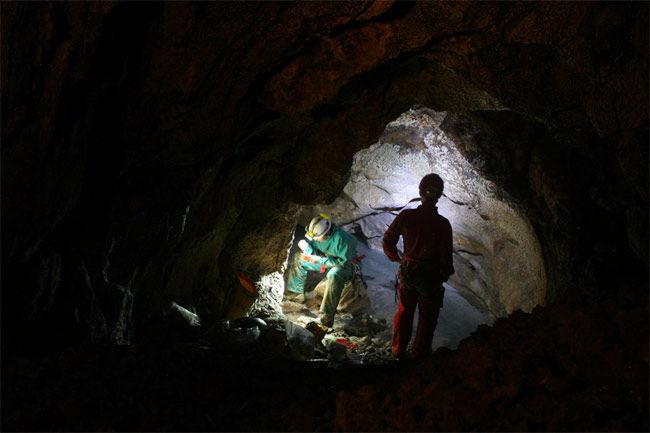Caves Reveal Evolution of Ancient Microbes

This Behind the Scenes article was provided to LiveScience in partnership with the National Science Foundation.
Recently, caving expert Simone Cerioni guided Jenn Macalady of Pennsylvania State University and her team of scientists up a dark, steep slope in the Frasassi cave system in central Italy. While climbing up a particularly difficult section, Cerioni turned around to check on the scientists scrambling below him, and noticed that their facial expressions — spotlighted by the narrow beams of their headlamps — seemed to ask him, "How do we get up this part?" Cerioni responded in his best Jedi English, "Use the force …” Taking Simone's advice, the scientists found their footing and climbed higher. Nevertheless, in other, gnarlier sections of the cave, Simone's encouragement of "the force" did not suffice, and the expedition advanced only with the help of hardware, such as ropes, harnesses and ascending gear. Why were Macalady and the other members of her research team negotiating such treacherous subterranean terrain? Because like many scientists who study the Earth's history, they dream of traveling back in time. But rather than wanting to travel back to the popular age of dinosaurs, they want to travel back to the Precambrian — a pivotal period which spanned from about 4.5 to 0.54 billion years ago. The Precambrian fascinates Macalady. "The evolutionary success of single-celled microbes during the Precambrian brought the Earth to life and set the stage for the evolution of multi-cellular organisms that thrive today," she says, adding that during the Precambrian microorganisms evolved the ability to produce oxygen from water through photosynthesis, a development that eventually led to the irreversible oxygenation of the Earth's surface. But because microorganisms leave poor fossil records, Macalady doesn't use the fossil record to study the Earth's oxygen revolution and the evolution of microbes. Instead, she studies these phenomena by analyzing modern microbial examples from Earth's anoxic (oxygen-free), dark regions. However, these organisms are rare and difficult to access, found only underwater or in deep, dark underground environments (or combinations of the two) where stagnant water or unusual chemical conditions prevent oxygen from penetrating. Caving worldwide So how does Macalady manage to access such remote dangerous environments? By collaborating with expert cavers and cave divers who guide her and her colleagues to locations that would otherwise be beyond their reach and sometimes collect samples of microbial communities on her behalf. So far, with funding from the National Science Foundation and NASA, Macalady has managed research collaborations between scientists and caving experts in dark, anoxic environments in Italy, Mexico, Florida and the Bahamas. To maximize the productivity of such collaborations, Macalady and her fellow researchers continually hone their own caving skills. They also train their caving guides to find and sample the types of environments that offer the most research potential and how to make critically important field observations. Mysterious cave microbes Why is Macalady so dedicated to exploring deep, dark, dangerous caves? Because so little is currently known about the microbes that live in dark, anoxic environments. "Every expedition offers the possibility of discovering previously unknown life forms and important clues to the history of life," she says. That day in the Frasassi caves, Macalady and her research team profiled the geochemistry of a remote, anoxic lake that was reached only after four hours of travel within the cave system. Once there, Ph.D. student Dan Jones and Italian cave explorer Sandro Mariani donned dry suits, entered the 55-degree Fahrenheit lake water, and lowered a geochemical probe into the lake's deep anoxic layer, which is located about eight meters below the lake surface. This is standard operating procedure: sometimes, Macalady's research team will even collect microbe samples in other microbial environments from depths of dozens of meters. Once back in the lab, Macalady's research team conducted laboratory analyses of the gene sequences contained in their microbe samples. These analyses were designed to reveal important information about the evolutionary relationships between sampled microbes and other known microbe species, and information about microbial activities. Slow-growing slime For example, through these analyses, Macalady's post-doc, Sharmishtha Dattagupta, identified a new animal-microbe relationship (or symbiosis) in the Frasassi cave system that is based on chemical energy. Such symbiosis, which is common around hydrothermal vents on the sea floor that spew hot water, had not previously been known to occur outside of the oceans. In addition, Italian cave divers discovered a slow-growing, anaerobic slime in the Frasassi cave waters; this slime contains large populations of cells that produce energy through novel methods that Macalady's research team is currently struggling to understand. Macalady's team, which includes Ph.D. students Jones, Kat Dawson, Heidi Albrecht, and Rebecca McCauley, is currently continuing to conduct research in the Frasassi caves as well as in other Italian caves. This work involves collaborations with a team of Italian colleagues that includes geologists Alessandro Montanari, Sandro Galdenzi and Maurizio Mainiero, and cave explorers Mariani, Cerioni and others. In her latest effort, she is researching collapsed, flooded caves in the Bahamas, a collaboration with expert cave diver Kenneth Broad from the University of Miami funded by National Geographic. Although the sinkholes hold fresh, oxygen-rich water near the surface, they quickly become salty and anoxic with depth. Therefore, Macalady suspects that these sinkholes, along with similar ones in Florida, may provide additional clues to the Earth's earliest environments. And that is just the kind of time travel that keeps her exploring the Earth's depths.
- 10 Species Success Stories
- Gallery: Microscopic Images as Art
- Bacteria: News and Information
Editor's Note: This research was supported by the National Science Foundation (NSF), the federal agency charged with funding basic research and education across all fields of science and engineering. See the Behind the Scenes Archive.
Sign up for the Live Science daily newsletter now
Get the world’s most fascinating discoveries delivered straight to your inbox.












